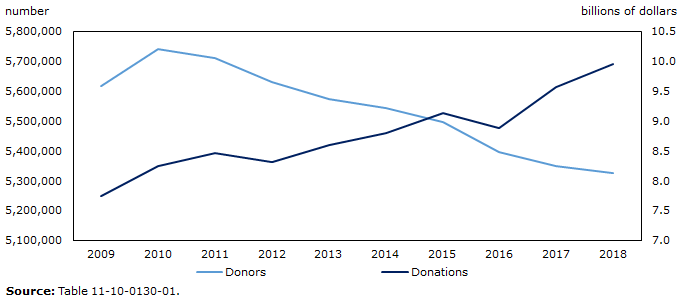Charitable donors, 2018
Archived Content
Information identified as archived is provided for reference, research or recordkeeping purposes. It is not subject to the Government of Canada Web Standards and has not been altered or updated since it was archived. Please "contact us" to request a format other than those available.
Released: 2020-02-14
While fewer Canadian tax filers made charitable donations in 2018, they were more generous than in 2017.
Donations by tax filers rise again
Total donations claimed on tax returns rose 3.9% in 2018 to just under $10.0 billion. While this marks a second consecutive year of increase, the growth was smaller than in 2017 (+7.7%).
In 2018, charitable donations rose most in Saskatchewan (+17.1%), following a decrease of 0.5% the previous year. Other notable increases were observed for Quebec (+5.7%) and Ontario (+5.6%).
Nationally, the median donation claimed by tax filers was $310 in 2018, meaning that half of these filers donated at least $310, while the other half donated less. Donors in Nunavut claimed the highest median donation ($540), while donors in Quebec claimed the lowest ($130).
Among census metropolitan areas, donors in Abbotsford–Mission (British Columbia) ($850) led the country with the highest median charitable donation for the 17th consecutive year, followed by donors in Lethbridge (Alberta) ($730).
Fewer tax filers claim charitable donations
From 2017 to 2018, the number of tax filers claiming donations declined 0.4% to 5,324,280, continuing a downward trend which began in 2011. Donor numbers were down across the country, with the exception of Ontario (+0.1%) and Quebec (0.0%). The largest decrease was observed in Nunavut (-5.5%).
Canadians with higher incomes and seniors are the most generous
Tax filers with incomes of $80,000 or more represented 35% of all donors in 2018. The relative importance of this group among donors has grown steadily since 2011, when they represented 27% of all donors.
Seniors aged 65 and older make up an important and growing share of tax filers that report donations. Since 2010, when looking at the age of tax filers, seniors have been the largest donor group. Growth observed from 2010 to 2018 in the number of tax filing seniors that donate (+7 percentage points) has outpaced growth in the number of seniors among tax filers (+4 percentage points). By 2018, seniors represented 31% of all tax filing donors in Canada, an increase from 24% in 2010. The higher share of seniors among donors was observed across the country, with the exception of the Northwest Territories (15%) and Nunavut (14%). In these two territories, there is a much lower concentration of tax filers in the 65 and older age group compared with the rest of the country.
Note to readers
Canadians contribute in many ways to charitable organizations. This release reports on charitable donations that are reported on tax files. These data include only amounts given to charities and approved organizations for which official tax receipts were provided and claimed on tax returns. To verify if a charity is registered under the Income Tax Act, tax filers can consult the Charity Listings available from the Canada Revenue Agency webpage. It is possible to carry donations forward for up to five years after the year in which they were made. Therefore, donations reported for the 2018 taxation year could include donations that were made in any of the five previous years. According to tax laws, tax filers are permitted to claim both their donations, and those made by their spouses to receive better tax benefits. Consequently, the number of donors is higher than the number who claimed tax credits.
Charitable donations promoted through crowdfunding platforms for individuals or organizations who are not linked to charities registered under the Income Tax Act, are not captured in this data release. Donations for small amounts, such as donations by text message where no tax receipts are issued, are also not covered. These donation methods may be more commonly used by younger tax filers.
Another source of donation data at Statistics Canada is the General Social Survey – Giving, Volunteering and Participating. This survey collects information on all monetary donations reported by individuals, regardless of whether or not the donation resulted in a tax credit.
All data in this release have been tabulated according to the 2016 Standard Geographical Classification used for the 2016 Census.
A census metropolitan area (CMA) is formed by one or more adjacent municipalities centred on a population centre (also known as the core). A CMA must have a total population of at least 100,000, of which 50,000 or more must live in the core.
Products
The document Technical Reference Guide for the Preliminary Estimates from the T1 Family File (T1FF) (11260001), which presents information about the methodology, concepts and data quality of this release, is now available.
Data on Charitable Donors (13C0014, various prices) and Canadian Taxfilers (17C0010, various prices) are now available for Canada, provinces and territories, economic regions, census divisions, census metropolitan areas, census agglomerations, census tracts, and postal-based geographies. These custom services are available upon request. Tables for this release are available for free on the Statistics Canada website for Canada, province and territories, census metropolitan areas and census agglomerations.
Contact information
For more information, or to enquire about the concepts, methods or data quality of this release, contact us (toll-free 1-800-263-1136; 514-283-8300; STATCAN.infostats-infostats.STATCAN@canada.ca) or Media Relations (613-951-4636; STATCAN.mediahotline-ligneinfomedias.STATCAN@canada.ca).
- Date modified:


